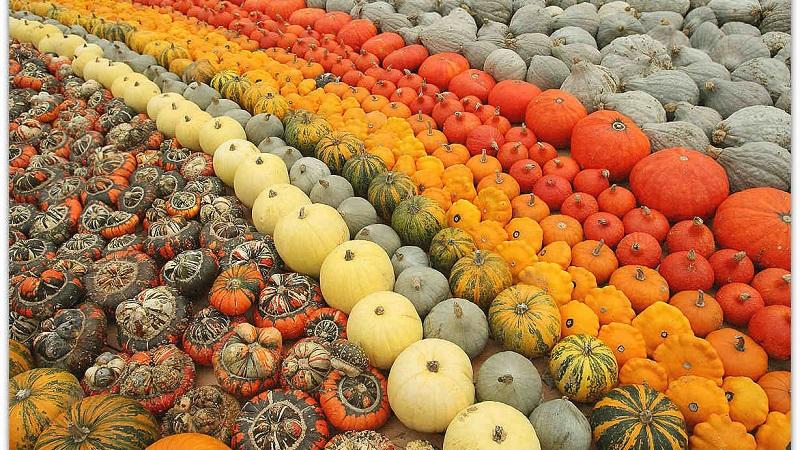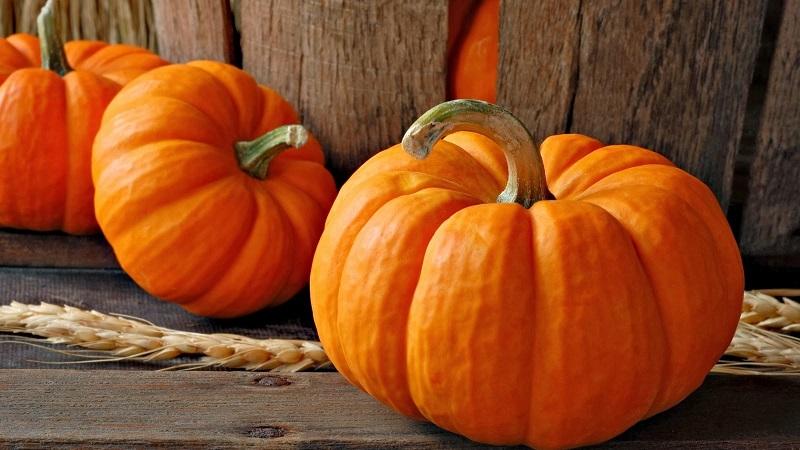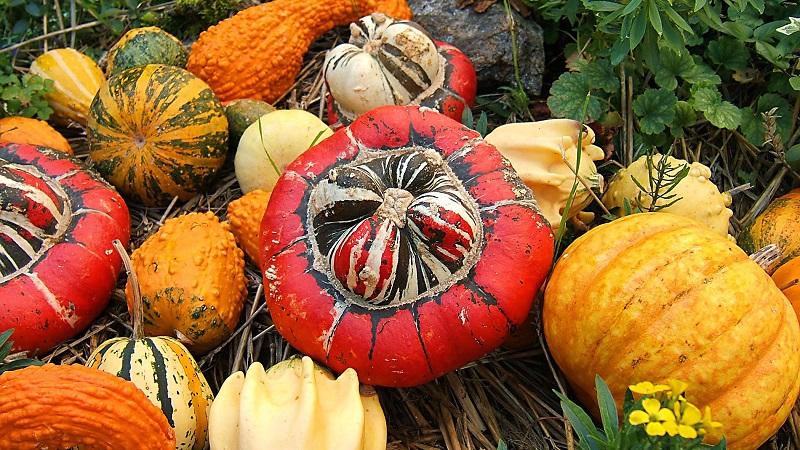The best varieties of bush pumpkin and features of their cultivation
Most experienced gardeners grow several varieties of pumpkin at the same time. The vegetable does not require special care. This is a fruitful crop: the immense size of the overgrown bush during the ripening period is considered by some farmers rather a disadvantage than an advantage.
But this is the opinion of those who have not come across a variety of subspecies of bush pumpkin - a plant with small in length and compact lashes. Consider what bush pumpkin varieties are and how to care for them.
The content of the article
Variety advantages and features
A bush pumpkin variety is ideal for growing in a small summer cottage, where every square meter is worth its weight in gold. It will take up some space in the garden. Its fruits are formed at the base, the shoots and stem are erect, which favorably affects the yield and makes it possible to better retain moisture at the roots.
The main advantages of a bush vegetable is early maturity, which favorably distinguishes the fruit from climbing "relatives". The beautiful fruits of the "sunny" subspecies have excellent taste. Most varieties have tender, sweet, juicy, carotene-rich pulp with a bright orange color.

Descriptions of varieties of bush pumpkin
There are dozens of varieties of bush pumpkin. Plants do not require special care and are resistant to temperature extremes. To get a high yield, they are planted in well-heated soil.
Smile
Gardeners appreciate the fruits of this variety primarily for their high taste. The Smile variety was bred about 15 years ago.
The thickness of the peel is small. The color of the vegetable is bright orange. There are hardly noticeable white stripes on the peel of the fruit. The pulp is firm, orange, has a sweet taste. The aroma is pronounced, similar to melon. The fruits of the Smile ripen quickly - in about three months. The shrub is low and compact.
The leaves are large, light green in color. Each Smile bush has about six powerful shoots about 1 meter in size.
Therapeutic
Early maturing, compact plant that tolerates temperature extremes. Fruits fully ripen 105 days after planting. The crop will delight you with good transportability and a long storage period (until May). Growing and caring in the open field does not require much effort.
The fruits of the Medicinal variety have a flattened-rounded shape and a weakly segmented surface, weighing up to 5.5 kg. The thin, leathery rind is light gray in color with small intermittent stripes. The pulp is thick, juicy, crunchy, sweet on the palate, light orange in color.

Pearl
Pumpkin Pearl grows well in open field conditions. Until the fruit is fully ripe after planting - 100-110 days. Pleases with a solid yield: 15 kg per 1 sq. m. Experienced gardeners note that seed The pearls are small.
Varietal fruits have a recognizable elongated-cylindrical shape, yellowish-orange color, smooth surface, weight reaches 7.5 kg. The thick flesh of the vegetable is reddish-orange in color. In terms of taste, "relatives" are not inferior to: it is sweet, juicy and tender.
The fruits are easy to transport over long distances, they are well stored.
Bush orange
Mid-season Orange Gourd will be stored until almost next year. Before the first fruits ripen - from 95 to 100 days after germination. The shrub orange variety is great for growing in Siberia, it is not afraid of sudden changes in temperature. One fruit gains up to 5 kg of weight.
An unpretentious plant requires standard care: moderate watering, weeding, loosening or mulching the row spacings. The flesh and rind are orange in color, the sugar content is low, therefore the variety is used for making stews, mashed potatoes, canning and freezing.
One hundred pound
Mid-late pumpkin yields 110-140 days after germination. The one-hundred-pound variety shows resistance to powdery mildew, bacteriosis and rot. The fruits are spherical and have a smooth surface. The peel of the vegetable is thin, yellow-orange. The flesh is loose, creamy yellow in color, moderately sweet. Productivity from 1 sq. m - up to 6.5 kg.
Amazon
The advantage of the Amazonka variety is the compactness of the plant. The vegetable belongs to the mid-season group. The crop is harvested from the bushes upon reaching 100-110 days after planting. The peel of the Amazon has a flat shape and a dark orange shell with white stripes. Fruit weight reaches 1-2 kg.
The pulp is bright orange in color, sweet and crunchy on the palate. The advantages of the variety include the ability to be stored for a long time, increased carotene content and transportability. The bushes are small in size, have powerful stems and dark green leaves.
Gribovskaya
This old variety is known to many summer residents of Russia. Most gardeners living in the Urals are interested in what varieties of vegetables are suitable for growing in their region. Farmers of the Urals should try Gribovskaya bush 189. This variety is unpretentious in relation to weather conditions.
The fruits of the Gribovsky bush variety reach 2.2-5 kg in weight. The pumpkin has an oblong obovate shape. Fruits are dark green in color. As it ripens, the rind changes color to a light orange.
The flesh of this fruit is orange, sweet and firm. The ripening period for Gribovskaya pumpkin is 85-90 days after planting. Many gardeners believe that this variety has the most delicious pulp of all pumpkins.
How to grow
No special agrotechnical techniques for caring for this crop are required, planting and care are standard.
Where and when to plant
The place is chosen on the site on the south side, since the plant needs heat. It is better to plant a crop in the place where such predecessors grew: potatoes, beet, onions, peppers.
The optimal time of the year for planting is the second half of May. Some gardeners plant a vegetable according to folk signs - during the flowering of peonies and viburnum.

Seed and seedling preparation
In the middle lane, pumpkin seeds are sown directly on the beds, then the sowing is covered with non-woven material. In regions with colder climates, seedlings are grown first. The seeds must be disinfected (a weak, pink solution of potassium permanganate is suitable), then they are germinated in a damp cotton cloth. The procedure will ensure the germination of all seeds and protect the plants from infections.
The plant is badly affected by transplanting, so peat pots will be needed for seedlings. For seedlings, it is necessary to allocate a sunny place on the windowsill, a suitable temperature for growing is about 25 ° C warm.
Important!By the time the pumpkins are planted, you will need to calculate the time so that the seedlings are at least 25-30 days old.
A week before the supposed planting of the pumpkin on the street, the plants are hardened - they are taken out on loggias, verandas or balconies.
Growing and caring for the garden
Planting and caring for a bush pumpkin is much the same as for a climbing crop. The place is chosen sufficiently lit and protected from the wind.
If necessary, the soil is deacidified by adding dolomite flour or chalk to it. To improve the structure of clay or loamy soil, peat and sand are added. The root system develops well when the soil is loose and permeable.
To increase fertility with digging, add:
- humus;
- compost;
- mineral fertilizers: potassium nitrate, superphosphate.
Planting pumpkins is done in two ways: by planting seeds in the ground or seedlings. The age of the finished seedlings for planting in open ground is 3-4 weeks. For planting seeds in open ground, the soil must be well warmed up.
Landing dates:
- middle lane - mid-May;
- Siberia, Urals - end of May, beginning of June.
The weather forecast is the main reference point for planting a pumpkin. The culture is thermophilic, and if there is a threat of return frosts, you should not rush to planting. If the plant was planted early, the covering material will save from frost. Planting of bush crops is carried out according to the standard scheme 60x60 cm.
Pumpkin loves regular watering with warm water. In case of short-term drought, the plant will not be affected, but prolonged drought can reduce yields. Watering fruits, flowers and leaves.
Council. Make a hole around the center shoot to allow water to enter.
Pumpkin loves feeding, but you should not get carried away with them. It will be enough to feed it with nitrogen fertilizer in the initial period, when the green mass grows well, and phosphorus-potassium preparations are suitable during the formation of fruits.
How to shape a bush pumpkin
Bush pumpkin does not require formation, you can limit yourself to removing female flowers at a time when a sufficient number of ovaries have formed. But you will need to pinch the main stem in order for the fruits to ripen better. How to pinch a pumpkin? This is done when the first pumpkin appears. The next time they pinch all points of plant growth in mid-August.
Important. If the leaves shade the pumpkin, carefully remove them.
Harvesting and storage
Each variety of bush pumpkin has its own maturity period. Determine it by its appearance. A dry cork-like leg indicates that the pumpkin is ripe. Slice off the pumpkin, leaving an oblong stem.
For your information. If the skin of the pumpkin is damaged under the stalk, it will start to rot.
Harvested in dry weather. Then pumpkins are laid out in the sun, or in a dry warm room. This will allow the skin to grow stronger, the pulp will become sweeter and denser, and the pumpkin will dry up and be ready for long-term storage.
A dry dark ventilated room with a temperature of 5-10 degrees is allocated for storage. The required humidity level is medium. If the humidity is high, the pumpkin will be stored for no more than two months.
Storing crops in a cellar will require shelving or pallets. Floor storage is not permitted. The pumpkin is laid out in one row with a small distance from each other, tails up.
On a note. Pumpkins that start to rot are best removed.
Storing pumpkins in an apartment is carried out on a warmed balcony in boxes so that no light gets in, at a temperature like in a cellar. Pantry storage will not last longer than three months due to the inappropriate temperature.
Reviews of summer residents
Before planting this or that variety, we advise you to read the opinion of experienced summer residents. Consider some of the testimonials taken on internet gardening forums.
Olga, Krasnoyarsk Territory: “It is not so easy to grow anything in our region, especially a pumpkin. I like bush pumpkins for their compact size. They are in my greenhouses, which I open during the day and cover them with foil at night. Bushes about the same as zucchini - very comfortably. As for me, unsweetened pumpkin is better. A vegetable should be a vegetable, so I chose the variety of Bushy orange pumpkin for myself, since it is low in sugar. Great for blanks and is stored for a long time. If you make a vegetable stew, the pumpkin pieces do not fall apart, they remain intact. Sometimes I throw it in the soup instead of potatoes. The only thing is, if the harvest is not picked on time, the pumpkin will grow up to 10 kg and more, become fibrous and tasteless. "
Ekaterina, Chelyabinsk region: “I have been growing Gribovskaya bush pumpkin for a long time. Since childhood, I remember how my grandmother raised it, now I grow it too. It is unpretentious and takes root very well in the harsh Chelyabinsk climate.I land when the ground warms up. I do not use a greenhouse - I grow it in the open field. From Mushroom pumpkin I make stews and jam, and I also freeze them in stew cubes. Fresh pumpkin makes wonderful cheese cakes and excellent porridge. "
Victoria, Volgograd region: “I don't really like frozen and preserved pumpkin, so I have been looking for a variety that will be stored for a long time. I tried many varieties until I accidentally found reviews on the Gribovskaya winter on the Internet. It is stored until the new harvest and does not deteriorate at all. Last year it was a very rainy summer, already at the beginning of April small specks began to be seen, indicating the beginning of rotting. My family and I began to eat actively sweet pumpkin... The remaining harvest was preserved until the summer. "
Conclusion
Pumpkin is an unpretentious vegetable that requires minimal care. The culture grows well in temperate and warm climates, especially in sunny, warm areas. By adhering to the minimum requirements of growing and feeding, you will definitely achieve a rich harvest.
An experienced gardener will tell us about other varieties of bush pumpkin with a photo and description: